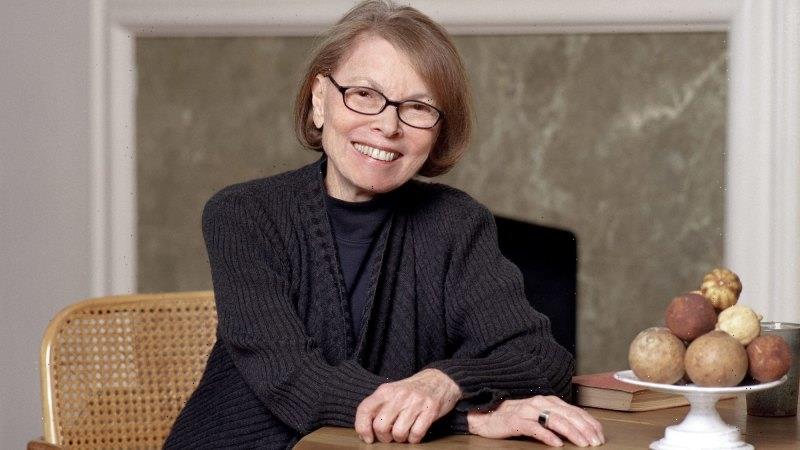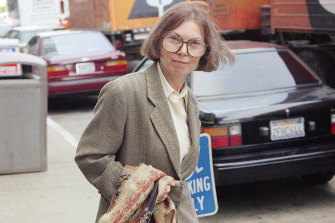Janet Malcolm, a longtime writer for The New Yorker who was known for her piercing judgments, her novel-like nonfiction and a provocative moral certainty that cast a cold eye on journalism and its practitioners, died Wednesday in a hospital in Manhattan. She was 86.
The cause was lung cancer, said her daughter, Anne.
Over a 55-year career, Malcolm produced an avalanche of deeply reported, exquisitely crafted articles, essays and books, most of which were devoted to her special interests in literature, biography, photography, psychoanalysis and true crime. Her writing was precise and analytical; her unflinching gaze missed nothing.
“Don’t ever eat in front of Janet Malcolm; or show her your apartment; or cut tomatoes while she watches,” critic Robert Boynton warned in 1992. “In fact, it probably isn’t a good idea even to grant her an interview, as your every unflattering gesture and nervous tic will be recorded eventually with devastating precision.”
Author Janet Malcolm’s writing was precise and analytical; her unflinching gaze missed nothing.Credit:Nina Subin
She herself was a cautious interviewee. When The New York Times Book Review in 2019 asked Malcolm, a voracious reader, what was on her nightstand, she replied: “My actual nightstand is a small wood table with a box of Kleenex, a two-year-old Garnet Hill catalogue and a cough drop on it.“
Whatever Malcolm was writing about, her real subject was often the writing process itself — the slipperiness of truth, the perils of the writer-subject relationship, the ethical choices that writers are constantly called to make. One of the throughlines in her work was a merciless view of journalism, never mind that she was one of its most prominent practitioners.
“Human frailty continues to be the currency in which it trades,” she wrote in Iphigenia in Forest Hills: Anatomy of a Murder Trial (2011). “Malice remains its animating impulse.”
The New Yorker writer Janet Malcolm leaving the Federal Courthouse in San Francisco in 1993.Credit:AP
Her most famous work was The Journalist and the Murderer, published as a two-part essay in The New Yorker in 1989 and as a book the next year. A forensic examination of the relationship between Joe McGinniss, a bestselling author, and Jeffrey MacDonald, a doctor who was convicted of murdering his family, it castigated McGinniss for pretending to believe in MacDonald’s innocence long after he was convinced of his guilt. Malcolm focused less on the murder — a story told many times over in articles, books, TV movies and podcasts — than on a lawsuit that MacDonald had brought against McGinniss, saying that he had deceived him.
Her essay began with one of the most arresting first sentences in literary nonfiction: “Every journalist who is not too stupid or too full of himself to notice what is going on knows that what he does is morally indefensible.”
Her pronouncement enraged the journalistic firmament. Many writers insisted that this was not how they treated their subjects and accused Malcolm of tarring everyone with the same broad brush.
But what galled some journalists about the piece the most, The Times reported in 1989, “was her failure, and that of her magazine, to disclose that Miss Malcolm had been accused of the same kind of behaviour, in a lawsuit filed against her by the subject of an earlier New Yorker article.”
“Every journalist who is not too stupid or too full of himself to notice what is going on knows that what he does is morally indefensible,” wrote Janet Malcolm.
That earlier article, a 1983 profile of flamboyant psychoanalyst Jeffrey Masson, led to a libel suit against Malcolm that hung over her during a decade of litigation and clouded her reputation even longer.
The legal allegations were different: The MacDonald suit accused McGinniss of fraud and breach of contract; the Masson suit accused Malcolm of libel. But both suits raised serious questions about journalistic ethics — MacDonald’s about the nature of writers’ obligations to their sources, and Masson’s about what constitutes quotations and what license, if any, reporters may take with them.
The journalistic community generally judged Malcolm harshly, mostly for the finding in the Masson case that she had cobbled together 50 or 60 separate conversations with the loquacious Masson and made them appear as if he had spoken them in a single lunchtime monologue.
“This thing called speech is sloppy, redundant, repetitious, full of uhs and ahs,” Malcolm testified in her defense in 1993 during the first of two jury trials. “I needed to present it in logical, rational order so he would sound like a logical, rational person.”
Among her critics was Anna Quindlen, then a Times columnist, who wrote that Malcolm’s technique was “beyond the pale.”
“This thing called life is sloppy,” Quindlen wrote, “and slice-of-life is what a reporter is meant to reflect, not some tidier or more dramatic composite version.”
The MacDonald case ended in a hung jury; to avoid a second trial, McGinniss settled with MacDonald for $US325,000. (MacDonald is still serving three life sentences.) In the Masson suit, the jury ruled that while two of five disputed quotations that Malcolm had attributed to Masson were false and that one of those was defamatory, none were written with reckless disregard of the truth, the standard under which libel damages would have been allowed.
In her afterword of the book version of The Journalist and the Murderer, Malcolm dismissed the notion that her criticism of McGinniss had been a “covert confession” of her treatment of Masson. And she lamented that because of inaccurate reporting, in The Times and elsewhere, about the Masson suit, she would “always be tainted — a kind of fallen woman of journalism.”
But with the passage of time, and the explosion of a far more complex and treacherous media landscape, her broadsides against her profession seem almost quaint.
In fact, The Journalist and the Murderer has become something of a classic and was ranked No. 97 on the Modern Library’s list of the 100 best nonfiction books of the 20th century.
“It is now taught to nearly every undergraduate studying journalism,” Katie Roiphe wrote in a 2011 profile of Malcolm in The Paris Review.
“Today, my critique seems obvious,” Malcolm told Roiphe, “even banal.”
Many contemporary writers, reviewing her subsequent work, ignore the lengthy legal and ethical entanglements of the McGinniss and Masson cases and have nothing but praise for Malcolm’s literary skill.
In a 2019 review in The Times of Malcolm’s book Nobody’s Looking at You, Wyatt Mason referred to the habit of some New Journalists to insert themselves in their stories and noted: “Taking no particular issue with the work of her colleagues, I wish nonetheless to say that Malcolm, line to line, is a more revealing writer, one whose presence in her pieces isn’t meant to advertise the self so much as complicate the subject. And also, line to line, she is a better writer.“
Janet Malcolm was born Jana Klara Wienerova on July 8, 1934, into a well-to-do Jewish family in Prague, in what was then Czechoslovakia. Her mother, Hanna (Taussigova) Wiener, was a lawyer. Her father, Josef Wiener, was a psychiatrist and neurologist.
In July 1939, when Janet was almost 5 and her sister, Marie, was a toddler, her parents scraped together enough money to bribe Nazis officials for an exit visa. (Family lore held that their money went to a Schutzstaffel, or SS, officer to buy a racehorse.) The family travelled by train to Hamburg, then to New York on one of the last civilian ships to leave Europe for America before the outbreak of World War II. Upon arrival, they changed their surname to Winn; Jana Klara became Janet Clara.
They initially stayed with relatives in Flatbush, Brooklyn, while her father studied for his medical boards. In 1940, they moved to the Upper East Side of Manhattan, where her father in effect became a village doctor to the large working-class Czech population that lived in the East 70s. Janet’s mother, by then known as Joan, worked for the Voice of America.
In kindergarten in Brooklyn, Janet had felt lost and stymied by her inability to comprehend English. But she quickly picked up the new language during her early years of schooling in Manhattan, although when her father’s mother moved in with them in 1941, they still spoke Czech at home for her benefit.
If learning English came easily to Janet, learning that she was Jewish did not. One day she repeated an anti-Semitic slur, prompting her parents to inform her that she was Jewish. By then, she had already internalised the anti-Semitism in the culture, she wrote in a New Yorker essay, Six Glimpses of the Past (2018).
“Many years later, I came to acknowledge and treasure my Jewishness,” she wrote. “But during childhood and adolescence I hated and resented and hid it.”
Janet attended the High School of Music and Art in Manhattan, then headed for the University of Michigan. She wrote for the school paper, The Michigan Daily, and the campus humour magazine Gargoyle, where, as managing editor, she produced a parody of The New Yorker.
“Her keen sense of parody has caught the attention of the campus,” wrote The Michigan Daily. “Many people consider the Gargoyle New Yorker parody the finest issue of a college humor magazine ever published.” She graduated in 1955 with a degree in English.
While in college, she met and married Donald Malcolm. He, too, was a writer, and they moved to Washington, where they both wrote for The New Republic. When he joined the staff of The New Yorker in 1957, they moved to New York. He later became the magazine’s first off-Broadway drama critic and then a book reviewer. In 1963, The New Yorker published Malcolm’s first piece, a six-stanza poem titled Thoughts on Living in a Shaker House.
Shortly thereafter, her husband, at the age of 32, acquired an unexplained illness that dragged on for years and from which he never recovered. (She described it to The Telegraph of London in 2013 as “a kind of misdiagnosed Crohn’s disease,” for which he underwent multiple unnecessary surgeries.) He died in 1975 at 43. In an obituary in The New Yorker, William Shawn, the magazine’s legendary editor, wrote that Malcolm had been an “immaculate” writer, adding: “Word by word, sentence by sentence, piece by piece, he tried to achieve something flawless, and most of the time he succeeded.”
At The New Yorker, Malcolm started by writing on “women’s” topics such as Christmas shopping and children’s books. She also wrote About the House, a monthly column on interiors and design. Hers was an expansive definition of “house” and yielded many memorable essays, including A House of One’s Own (1995), in which she described how Virginia Woolf’s sister, painter Vanessa Bell, had transformed a Sussex farmhouse in England into the celebrated artists’ colony known as Bloomsbury.
Among Malcolm’s first editors at The New Yorker was Gardner Botsford. The intensity of the editing process drew them together, and they married in 1975, after both of their spouses had died. Botsford, whose stable of New Yorker writers included Roger Angell, A.J. Liebling and Joseph Mitchell, died in 2004 at 87.
In addition to her daughter, Malcolm is survived by her sister, Marie Winn; a granddaughter, Sophy Tuck; and two nephews.
At her husband’s memorial service, Malcolm said that during their first editing session, he “transformed bumpy writing into polished prose.” She became so reliant on his deft red pencil, she said, that over the years, “I became more blase about his editing, as one does about indoor plumbing.”
Another influence on her as a writer stemmed from her decision to give up smoking in 1978. She realised that she couldn’t write without cigarettes, so she avoided writing by immersing herself instead in researching and reporting. The result was a lengthy article called The One-Way Mirror, about family therapy.
“By the time she finished the long period of reporting,” Roiphe wrote in The Paris Review, “she found she could finally write without smoking, and she had also found her form.”
That idiosyncratic form has been described in different ways by different writers. Roiphe put it this way: “She takes apart the official line, the accepted story, the court transcript like a mechanic takes apart a car engine and shows us how it works; she narrates how the stories we tell ourselves are made from the vanities and jealousies and weaknesses of their players. This is her obsession, and no one can do it on her level.”
This article originally appeared in The New York Times.
The Booklist is a weekly newsletter for book lovers from books editor Jason Steger. Get it delivered every Friday.
Most Viewed in Culture
From our partners
Source: Read Full Article








